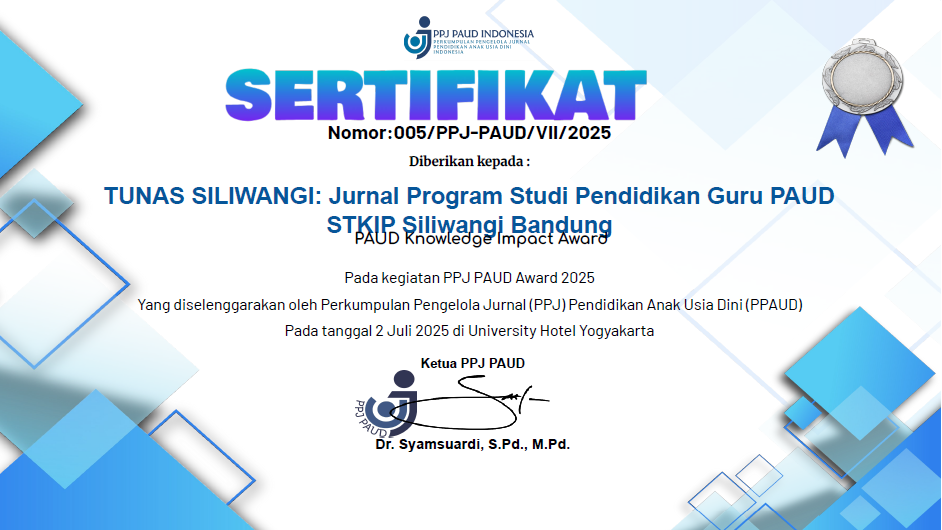METODE FONIK DALAM PEMBELAJARAN MEMBACA PERMULAAN BAHASA INGGRIS ANAK USIA DINI
DOI:
https://doi.org/10.22460/ts.v5i1p29-43.1271Abstract
Penelitian ini bertujuan untuk menginvestigasi mengenai implementasi metode fonik dalam pembelajaran membaca permulaan Bahasa Inggris untuk anak usia dini. Studi kasus dilakukan di I Can Read, sebuah lembaga bimbingan belajar Bahasa Inggris di Kota Bandung. Penelitian ini mencoba untuk menganalisis tahapan pembelajaran dan kendala yang dihadapi guru dalam pengimplementasian metode fonik. Analisis tematik digunakan dalam penelitian ini terhadap data wawancara, catatan observasi, dan studi dokumentasi. Hasil dari penelitian ini menunjukkan bahwa tahapan pembelajaran disesuaikan dengan kebutuhan anak. Kemudian, kendala yang dirasakan oleh guru adalah keterbatasan waktu dan perbedaan kemapuan anak. Selain itu, guru-guru percaya bahwa implementasi metode fonik dalam pembelajaran membaca permulaan Bahasa Inggris untuk anak usia dini sudah sesuai karena tahapan pembelajarannya dimulai dari pengenalan bunyi huruf, pengenalan simbol huruf, hingga penggabungan bunyi huruf. Pembelajaran melalui metode fonik dapat dikolaborasikan dengan bermain dan bercerita agar suasana pembelajaran menjadi lebih menyenangkan bagi anak. Simpulan dari penelitian ini adalah implementasi metode fonik banyak membantu guru untuk memperkenalkan konsep bunyi huruf yang merupakan pondasi awal dalam pembelajaran membaca permulaan Bahasa Inggris.Kata Kunci: Metode Fonik, Membaca Permulaan Bahasa Inggris, Anak Usia Dini
References
Adams, M. J. (1994). Beginning to read : Thinking and learning about print. Cambridge: First MIT Press.
August, D., & Shanahan, T. (Eds.). (2006). Developing literacy in second-language learners: Report of the National Literacy Panel on Language-minority Children and Youth. Mahwah, NJ: Erlbaum.
Bald, J. (2007). Using phonics to teach reading and spelling. London: Paul Chapman Publishing.
Barac, R., Bialystok, E., Castro, D. C., & Sanches, M. (2014). The cognitive development of young dual language learners: A critical review. Early Childhood Researc Quarterly, 1-17. http://dx.doi.org/10.1016/j.ecresq.2014.02.003.
Barone, D.M (2011). Children’s literature in the classroom. New York: The Guilford Press.
Carlisle, A. A., Thomas, C. N., & McCathren, R. B. (2016). The effectiveness of using a content acquisition Podcast to teach phonological awareness, phonemic awareness, and phonics to preservice special education teachers. Journal of Special Education Technology, 1-12. DOI: 10.1177/0162643416651723.
Castro, D., Páez, M. M., Dickinson, D. K., & Frede, E. (2011). Promoting language and literacy in young dual language learners: Research, practiceand policy. Child Development Perspectives, 5(1), 15–21. http://dx.doi.org/10.1111/j.1750-8606.2010.00142.x
Chai, Z., Ayres, K., & Vail, C. O. (2016). Using an iPad App to improve phonological awareness skills in young English-Language Learners with disabilities. Journal of Special Education Technology, 31 (1), 14-25. DOI: 10.1177/0162643416633332.
Chang et.al. (2010). Exploring the possibility of using humanoid robots as instructional tools for teaching a second language in primary school. Educational Technology & Society, 13 (2), 13-24. ISSN: 1436-4522.
Creswell, J. W. (2004). Research design: Qualitative, quantitative, and mixed methods approaches (2nd ed.). California: Sage Publications.
Daud, B., & Salamah, U. (2016). Teaching phonics and phonemic awareness in English beginning reading. English Education Journal, 7 (3), 329-340.
Durst, E., & Joseph, L. M. (2016). Helping preschoolers develop phonemic awareness skills using sound boxes. Dialog, 19(3), 94-98.
Ellison, M. (2015). CLIL : The added value to English language teacher education for young learners, LINGVARVM ARENA, 6, 59–69.
Farokhbakht, L., Nejadansari, D. (2015). The effect of using synthetic multisensory phonics in teaching literacy on EFL young learners’ literacy learning. International Journal of Research Studies in Education, 4(4), 39–52.
Fraenkel, J. R. Wallen, N. E., & Hyun, H.H. (2012). How to design and evaluate research in education. (8th ed.). New York: McGraw-Hill.
Greeve, M. S. (2007). Phoncis for dummies. New York: Wiley Publishing Inc.
Griffith, L. P., & Olson, W. M. (2004). Phonemic awareness helps beginning readers break the code. Reading Teacher, 45 (7), 516-523.
Huennekens, M. E., & Xu, Y. (2015). Using dialogic reading to enhance emergent literacy skills of young dual language learners. Early child development and care, 1-17. https://doi.org/10.1080/03004430. 2015.1031125. ISSN: 1930-9325.
Jamaludin, K. A., Alias, N., & Mohd, R. J. (2015). The effectiveness of synthetic phonics in the
development of early reading skills among struggling young ESL readers. School Effectiveness and School Improvement : An International Journal of Research, Policy and Practice,1-18. https://doi.org/10.1080/ 09243453.2015.1069749.
Konza, D. (2011). Research into practice: Understanding the reading process. http://www.decs.sa.gov.au/literacy/files/links/UtRP_1.2.pdf. Diakses pada Jumat, 21 April 2017.
Larsen-Freeman, D. (2012). On the roles of repetition in language teaching and learning. Applied Linguistics Review, 3(2), 195-210. ISSN: 1868-6311.
Lesaux, N. K. (2012). Reading and reading instruction for children from low-income and non-English-speaking-households. The Future of Children, 22, 73–88.
Lonigan, C. J., Purpura, D. J., Wilson, S. B., Walker, P. M., & Clancy-Menchetti, J. (2013). Evaluating the components of an emergent literacy interventions for preschool children at risk for reading difficulties. Journal of Experimental Child Psychology, 114, 111–130.
Lynch, J., & Redpath, T. (2012). ‘Smart’ technologies in early years literacy education: A meta-narratice of paradigmatic tensions in iPad use in an Australian preparatory classroom. Journal of Early Childhood Literacy, 1-28. DOI: 10.1177/1468798412453150.
Lyster, S. A., Lervag, A. O., & Hulme, C. (2016). Preschool morphological training produces long-term improvements in reading comprehension. Read and Writing, 29, 1269-1288. DOI 10.1007/s11145-016-9636-x.
Mamun, MD. A. A. (2014). Effectiveness of audio-visual aids in language teaching in tertiary level. (Thesis). BRAC University, Dhaka. Diakses pada tanggal 25 Mei 2015 dari http://dspace.bracu.ac.bd/bitstream/handle/ 10361/3288/13177014.pdf.
Marion, T. (n.d). How do teacher’s gestures help young children in second language acquisition? Université Paris 7, UFR Linguistique, Laboratoire ARP. Diakses pada tanggal 26 Mei 2015 dari http://gesture-lyon2005.ens-lyon.fr/article.php3? id_article=253.
Milne, E. D., & Garcia, A. L. (2008). The role of repetition in CLIL teacher discourse: a comparative study at secondary and tertiary levels. International CLIL Research Journal, 1 (1), 50-59. Diakses pada tanggal 31 Januari 2015 dari http://www.icrj.eu/11/article4.html.
Mohammed, N., Ghoneim, M., & Elghotmy, H. E. A. (2015). The effect of a suggested multisensory phonics program on developing kindergarten pre-service teachers’ EFL reading accuracy and phonemic awareness. English Language Teaching, 8(12), 124–143. https://doi.org/10.5539/elt.v8n12p124.
National Institute of Child Health and Human Development (NICHD). (2000). Report of the National Reading Panel. Teaching children to read: An evidence-based assessment of the scientific research literature on reading and its implications for reading instruction (NIH Publication No. 00-4769).Washington, DC: U.S. Government Printing Office.
Naughton, G. M., & Hughes, P. (2009). Doing action research in early childhood studies: A step by step guide. Open University Press.
Othman, J., & Kiely, R. (2016). Preservice teachers’ beliefs and practices in teaching English to young learners. Indonesian Journal of Applied Linguistucs, 6 (1), 50–59.
Otto, B. (2015). Perkembangan bahasa pada anak usia dini (3rd ed.). Jakarta: Prenamedia Group.
Paul, D. (2003). Teaching English to children in Asia. Quarray Bay, Hongkong: Longman Asia ELT.
Pinter, A. (2006). Teaching young language learners. Oxford: Oxford University Press.
Puspitasari, A.D., Hafidah, R., & Sujana, Y. (2016). Pengaruh phonics method terhadap kemampuan membaca permulaan anak kelompok B TK Aisyiyah Bustanul Athfal Kertonan. Kumara Cendekia.
Reiser, R. A., & Dick, W. (1996). Instructional planning: A guide for teachers (2nd Ed.). Massachusetts: A Simon & Schuster Company.
Sadjaah, E., & Sukarja, D. (1995). Bina bicara, persepsi bunyi, dan irama. Bandung: Dirjen Dikti Proyek Tenaga Guru Depdikbud.
Santrock, J. W. (2007). Child Development. Texas: McGraw-Hill.
Santrock, J.W. (2002). Life-span development (8th Ed.). New York: McGraw-Hill.
Saracho, O. N. (2016). Research, policy, and practice in early childhood literacy. Early Child Development and Care, 1-17. DOI: 10.1080/03004430.2016.1261512.
Saville, K. (2011). Strategies for using repetition as a powerful teaching tool. Music Educators Journal, 98(1), 69-75. doi: 10.1177/0027432111414432. Diakses pada tanggal 3 Januari 2015 dari http://mej.sagepub.com.
Seefeldt, C., & Wasik, B. A. (2008). Pendidikan anak usia dini: Menyiapkan anak usia tiga, empat, dan lima tahun masuk sekolah. Jakarta: PT. Indeks.
Skibbe, L. E., Gerde, H. K., Wright, T. S., & Samples-Steele, C. R. (2016). A content analysis of phonological awareness and phonics in commonly used head start. Early Childhood Education Journal, 44, 225-233. DOI 10.1007/s10643-015-0703-8
Suggate, S. P., Schaughency, E. A., & Reese, E. (2013). Children learning to read later catch up to children reading earlier. Early Childhood Research Quarterly, 28, 33-48.
Temple, J. D., & Snow, C.E. (2003). Learning words from books In A.V. Kleeck, S.A.Stahl, & E.B. Bauer (Eds.), On reading books to children (pp. 15-34). New Jersey: Lawrence Erlbaum Associates, Inc.
Tuan, L.T., & An. P. T. V. (2010). Teaching English rhythm by using songs. Studies in Literature and Language, 1 (2), 13-29. ISSN: 1923-1555. Diakses pada tanggal 19 Februari 2015 dari http://cscanada.net.
Wahyuni, N.T., Fauziati, E. (n.d.). The effectiveness of using phonics-based instructions in English reading classes to improve students’ participation. The First International Conference on Child-Friendly Education, 353–368.
Wake, D. G., & Benson, T. R. (2016). Preschool literacy and the common core: A professional development model. Journal of Education and Learning, 5(3), 236-251. ISSN 1927-5250.
Wang, Y., Yinb, L., McBride, C. (2015). Querterly unique predicators of early reading and writing: A one-year longitudinal study of Chinese kindergarteners. Early Childhood research Quarterly, 32, 51-59.
Whitehurst, G., & Lonigan, C. (2001). Emergent literacy: Development from preread-ers to readers. In S. B. Neuman & D. K. Dickinson (Eds.), Handbook of early literacy research (pp. 11–29). New York: Guilford.
Woodside, A. G. (2010). Case study research:Theory. Methods. Practice. Bingley: Emerald Group Publishing Limited.
Wortham, S. C. (2006). Early childhood curriculum: Developmental bases for learning and teaching (4th ed.). New Jersey: Pearson.
Wulandari, T. R., & Apriani, D. W. (2014). Singing and dancing in English for young learner’ classroom. (Article). Universitas Bina Darma, Indonesia. doi: 10.7763/IPEDR. Diakses pada tanggal 13 November 2014 dari http://www.ipedr.com/ vol77/010-ICLMC2014_N00021.pdf
Downloads
Published
Issue
Section
License
Copyright (c) 2025 Sharina Munggaraning Westhisi

This work is licensed under a Creative Commons Attribution-ShareAlike 4.0 International License.
The author is responsible for acquiring the permission(s) to reproduce any copyrighted figures, tables, data, or text that are being used in the submitted paper. Authors should note that text quotations of more than 250 words from a published or copyrighted work will require grant of permission from the original publisher to reprint. The written permission letter(s) must be submitted together with the manuscript.






